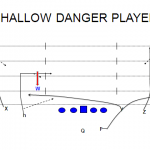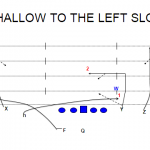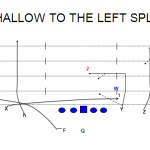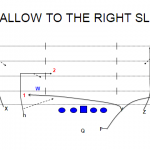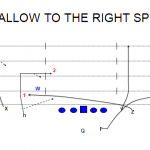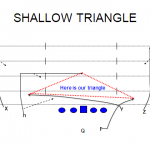In our offense, we currently hang our hat on four main drop back concepts and five quick throws. Today, I plan on discussing our “shallow” game. When looking at different passing schemes, we felt that the “Air Raid” shallow cross game was a very inexpensive play to install, but had a high potential for return on investment. We began making the shallow a staple of our drop back passing game. We run our shallow game from numerous formations. In addition, we run our shallow to any receiver on the field, which makes us almost impossible to key on.
By running different receivers on shallows, it allows us to break tendencies that may develop, but more importantly, it gives us a way to designate our most explosive athlete the shallow runner. We are trying to get the ball to playmakers in space. Lastly, how we teach the concept is different for some. We teach the concept as a whole to our receiving core and not just their individual route assignments. Every receiver is inter-changeable in our shallow game. I feel what sets our shallow game apart from other high school programs are the multiple looks we give.
The rules for our shallow cross are fairly standard. They are as follows:
Shallow Runner: Be no more then 6 yards from the near OT at the snap of the ball. Upon the snap, release immediately for the heels of the near DE gaining no depth. Run over his heels and through the tackle box with speed. Work for a depth of 1-3 yards on the opposite sideline. Don’t stop running.
Dig Runner: the first slot opposite the shallow is the dig runner. Be no closer then five yards and no further then eight from the near OT. Release vertically for the outside shoulder of the alley defender. Push through the outside shoulder of the alley defender. This a non- negotiable point for us. We must cause that defender to turn his head with our release. Push vertical 10 yards. Then, fire and bring it across. Run versus man coverage and sit versus zone. If you sit, find a window to the QB off the MLB and give him hands and eyes. (We teach our receivers to read zone or man coverage by peeking at the receiver coming on the shallow. If he has a defender trailing him, it is man. If no defender is trailing, it is zone).
Other WRs: Mandatory vertical outside release. Run a route down the top of the numbers. Snap head and eyes on your third step and be prepared to throttle down for the back shoulder throw.
With our shallow cross we encourage our shallow runner to be off the ball. Our players in our offense have the freedom to determine on every play which receiver is on the ball and which is off. Therefore, when teaching this play we try to ingrain it in their memory that they would prefer to be off the ball. In addition, we also teach our split receivers that they can get to their ideal shallow spot in one of two ways by alignment (compressing their alignment to the hash) or with movement (going in short motion). This is another area where we give them freedom, but it must be noted that our QBs must be aware of this so pre-snap they give the shallow runner time to motion, if needed.
Our QB is taught to read this play the opposite of how many others typically read this play. We stick with the Air Raid style of reading this play, which is to work the progression of shallow to dig to shoot. We have our QBs programmed with this progression very early on. We accomplish this by having our QBs recite their progression to a concept of the day every time they take a snap in our pre-practice warm up drills, such as the settle and noose drill.
We read the play this way for two reasons. One, it is keeping with our idea of “building triangles” in the passing game. Our QBs know that almost every concept we install has their read progressions in a triangle. This idea makes it very easy for them to commit to memory not only the progressions but where the ball should be delivered.
Second, we give the QB a specific defender to key on. We are not big on keying defenders, but rather we like reading grass. Yet in this case, we tell them the “Will” LB is the “Danger” player. He can blow up your shallow runner or pick six you if you don’t know what he is doing. Essentially, to make life easier on our QB we have found that by telling our QB “throw the shallow until they take it away” we get the right reactions in our shallow game.
I hope you found this post interesting. Hopefully, I have provided you with a useful piece of information to use in your program.
.
